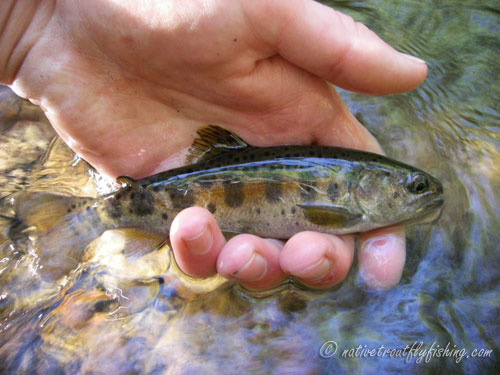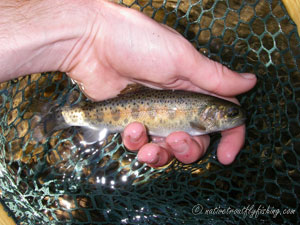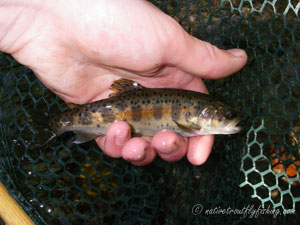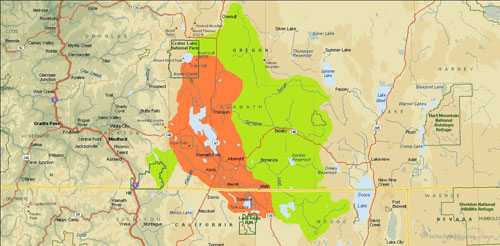Klamath Headwaters Redband
Oncorhynchus mykiss newberrii
A Klamath Headwaters Redband from a small stream in southern Oregon.
Introduction
The Klamath Headwaters Redband Trout are a phenotypically and genetically distinct group of Redband Trout found in the headwaters of the Klamath Basin in Oregon, including the Upper Williamson River above a barrier fall, the Sprague River upstream of Trout Creek, the Lost River and Jenny Creek above the falls (Behnke 1992, Currens et al. 2009, Pearse et al. 2011). This lineage is thought to be a more ancient form than the Redbands found in Klamath Lake.
Life History Information
The Klamath Headwaters Redbands exhibit fluvial and stream resident life history forms. Despite the lack of complete barriers to separate the Upper Klamath Lake and Klamath Headwaters Redband Trout in some watersheds, the two groups appear use different parts of the basin for spawning habitat and thus have been able to avoid hybridization with each other (Behnke 2002). Many of the streams in the basin spring fed, with extremely abundant aquatic invertebrates, which allows these fish to reach large sizes. Stream resident populations are found in the basin's headwater streams and might only travel only a mile or so during their entire lifespan. Due to their smaller living space these fish generally reach a maximum size of around 8” to 10” (20 to 25 cm) on a diet composed mainly of aquatic and terrestrial insects (Behnke 2002, Moore 2006). Klamath Headwaters Redband Trout spawning primarily between April and June, with the first spawning event at age-2 to age-3 (ODFW 2016).
Status
Like other native trout, the Klamath Headwaters Redband Trout has seen declines and the losses of some populations due to anthropogenic factors. These factors include, the introduction of non-native fish, agricultural impacts (especially water diversions and withdrawals), logging and drought (ODFW 2005). Along with Great Basin Redband Trout populations, the Redband Trout of the Klamath Headwaters were petitioned to be listed under the Endangered Species Act in 1997, but this listing was denied (USFWS 1997). Oregon considers these fish at risk of extinction and as recently as 2010, the entire Lost River population of Redbands may have been extirpated. Redband Trout in the Lost River were historically found in Miller Creek, where they were quite abundant. Unfortunately, during the winter of 2010 the water flow into the creek from Gerber Dam was accidentally shut off and no Redbands have been found in the basin either above or below the dam since (ODFW 2016). In other parts of the Klamath Basin significant strides have been made to improve irrigation structures, with better screening and fish passage to aid Redband Trout survival and migration. Across the rest of their range, another significant impact to these Redbands have been the introduction of non-native trout (Rainbow Trout, Brook Trout and Brown Trout). Unlike, in other Redband populations where the Redbands are typically the dominant species where the co-occur with Brook Trout, in the Upper Klamath, Brook Trout tend to outnumber Redbands by at least 3 to 1 where they are found (ODFW 2016). Some level of hybridization has also occurred where hatchery Rainbow Trout have been planted, leading to a loss of fitness in some populations. Another significant threat to these Redbands is drought and the wildfires that come with it. As of this writing the 2021 Bootleg Fire has burned over 340,000 acres (1,376 km2) in the upper Klamath Basin, ravaging many of the core populations of Redbands in the upper Sprague and Sycan Rivers. The total impact of this fire is unknown at this point, but it is likely that a number of populations will be lost when all is said and done.
Description
These fish have an olive or to bronze coloration on the back that transitions to a gray or yellowish color across the body. Klamath Headwaters Redbands typically have a wide brick red stripe along their lateral line, and their gill plates are a rosy or brick red color. The spotting pattern consists of small to medium sized round or irregular shaped spots that are distributed primarily above the lateral line and on the caudal and dorsal fins. Purplish colored elliptical shaped parr marks are often retained into maturity on stream resident fish but fade on fluvial fish. The dorsal fin may be tipped with either orange or white and the lower fins are tipped with white.
Stream Resident Form
Click on images to view a larger picture
Native Range
A map of the native range of the Klamath basin Redband Trout. Upper Klamath Lakes Redband Trout range in orange and Klamath Headwaters Redband Range in green. Data Sources: Behnke (2002) and ODFW (2005), Pearse et al. (2011).
References
Behnke, R. J. 1992. Native trout of western North America. American Fisheries Society Monograph 6. American Fisheries Society, Bethesda, Maryland.
Behnke, R. 2002. Trout and Salmon of North America. Chanticleer Press, New York.
Currens, K.P., C.B. Schreck and H.W. Li. 2009. Evolutionary ecology of redband trout. Transactions of the American Fisheries Society 138: 797–817.ODFW. 2005. Oregon native fish status report. Oregon Dept. of Fish and Wildlife, Salem, OR.
Moore, T. 2006. Distribution and abundance of bull trout and redband trout in Leonard and Deming Creeks, July and August, 2005. Native Fish Investigation Project, Oregon Department of Fish and Wildlife, Corvallis.
ODFW. 2005. Oregon native fish status report. Oregon Dept. of Fish and Wildlife, Salem, Oregon.
ODFW. 2016. Klamath watershed district stock status review of native fish. Oregon Department of Fish and Wildlife, Klamath Falls, Oregon.
U.S. Fish and Wildlife Service (USFWS). 1997. A petition for rules to list great basin redband trout (Oncorhynchus mykiss ssp) as threatened or endangered under the Endangered Species Act. Oregon Natural Desert Association, Portland, OR.
Contact
Feel free to contact me if you have any questions or comments
Klamath Headwaters Redband Trout Links
My Klamath Headwaters Redband Trips
Oregon Department of Fish and Wildlife - Redband Trout
Fremont-Winema National Forest
Klamath Marsh National Wildlife Refuge
Western Native Trout Initiative - Interior Redband Trout
Native Trout Links
Truchas Mexicanas' - Native Trout of Mexico
Balkan Trout Restoration Group
Trout and Seasons of the Mountain Village - About Japanese Trout
Western Native Trout Challenge
California Heritage Trout Challenge
Fly Fishing Blogs
Dave B's Blog: Fly Fishing for Native Trout
The Search for Native Salmonids
Conservation Links
Western Native Trout Initiative
Fly Fishing Links
Fishing Art Links
Americanfishes.com - Joseph R. Tomelleri



